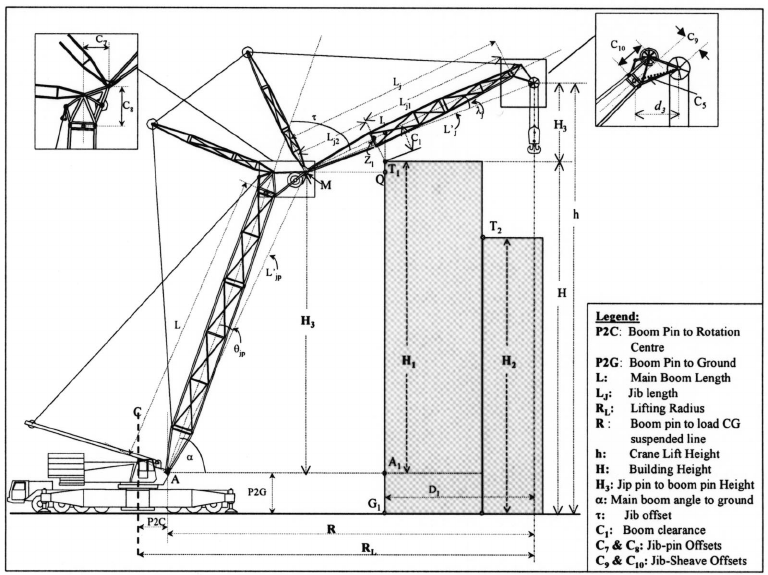Boom vs. Jib: What’s the Difference and Why It Matters in Canadian Lifting Operations
Boom vs. Jib: What’s the Difference and Why It Matters in Canadian Lifting Operations
When discussing cranes and lifting equipment, the terms "boom" and "jib" are often used interchangeably—but they refer to two distinct components that play very different roles in crane operation. Understanding the difference between a boom and a jib is essential for safe, efficient lifting, especially in Canada’s highly regulated industrial landscape.
What is a Boom?
The boom is the primary arm of a crane. It's the main structural component that enables the crane to lift and move heavy loads. The boom extends either telescopically or via lattice segments and typically supports the largest share of a crane’s lifting capacity.
Key Features of a Boom:
Main lifting structure
Can be hydraulic (telescopic) or lattice
Provides vertical reach and support
Directly connected to the crane base or turntable
What is a Jib?
The jib is an extension or attachment mounted to the end of the boom. It’s used to increase horizontal reach, enabling the crane to lift loads further from the centerline. Jibs are especially useful for reaching over obstacles, like buildings or other equipment.
Key Features of a Jib:
Secondary arm attached to the boom
Provides additional reach and articulation
Typically supports lighter loads
Often adjustable or fixed at an angle


Where You’ll Find Them in Use
In Canada, booms and jibs are used across construction, energy, forestry, marine, and mining sectors. Cranes with both components are crucial for projects requiring high lifts or extended reach—think of high-rise developments in Toronto, wind turbine installations in Alberta, or shipyard operations in Nova Scotia.
Booms in Action:
Mobile Cranes: Used on construction sites for moving heavy materials.
Tower Cranes: Used in urban environments for vertical construction.
Knuckle Boom Cranes: Found on trucks or marine vessels, combining power with flexibility.
Jibs in Action:
Luffing Jib Cranes: Often used in urban areas where space is limited.
Articulating Jibs: Ideal for warehouses or workshops needing reach over obstacles.
Jib Cranes (freestanding or wall-mounted): Common in manufacturing for repetitive lifting.
Safety and Load Considerations
It's critical to understand the load limits of both booms and jibs. A jib adds leverage, which can reduce the crane’s overall load capacity when extended. Overloading either component can lead to tipping, structural failure, or serious safety incidents.
According to WorkSafeBC, improper crane setup—including overextension of the boom or misuse of the jib—is a leading cause of lifting incidents. The Canadian Centre for Occupational Health and Safety (CCOHS) stresses the need for trained operators and regular equipment inspection.
Regulatory Oversight in Canada
In Canada, crane operation and equipment must comply with:
Canadian Standards Association (CSA) standards like Z150 (Safety Code on Mobile Cranes)
Provincial OHS regulations
Requirements for certified riggers and operators
Crane components, including booms and jibs, must also be inspected regularly by certified professionals. For example, in Ontario, cranes are subject to TSSA regulations, and in Alberta, inspections must align with the Alberta Elevating Devices & Amusement Rides Safety Association (AEDARSA).
Industry Stats: The Canadian Crane Landscape
The crane rental industry in Canada is valued at over $2.5 billion CAD (IBISWorld, 2024).
Over 60,000 cranes are estimated to be in use across the country.
Construction accounts for over 75% of crane usage, with infrastructure and industrial projects following closely.
Workplace incidents involving cranes have decreased 10% over the last five years, thanks to improved training and adherence to standards—highlighting the importance of proper boom and jib usage.
Why the Difference Matters
Understanding the roles of a boom and a jib helps:
Choose the right crane for the job
Improve safety on-site
Optimize load planning and lifting strategy
Ensure compliance with Canadian regulations
Reduce the risk of equipment damage or downtime
When selecting a crane, consider whether you need more height (boom) or more reach (jib)—or both. And always consult a qualified rigging or lifting expert before planning a lift.
Conclusion
In the world of cranes and lifting, the boom is your core muscle, doing the heavy lifting—while the jib is the arm extension, reaching into the tight spots. Understanding how they work together not only boosts your efficiency, but also helps maintain the highest safety standards on Canadian job sites.
Need help determining the right lifting setup for your project? Trust the experts at Hercules Crane & Lifting Supplies. From rigging gear to custom lifting solutions, we’re here to lift you up—safely and efficiently.
——————————————————————————————————————————————
The Hercules Group of Companies encompasses a wide portfolio of products and services across multiple, diverse companies.

